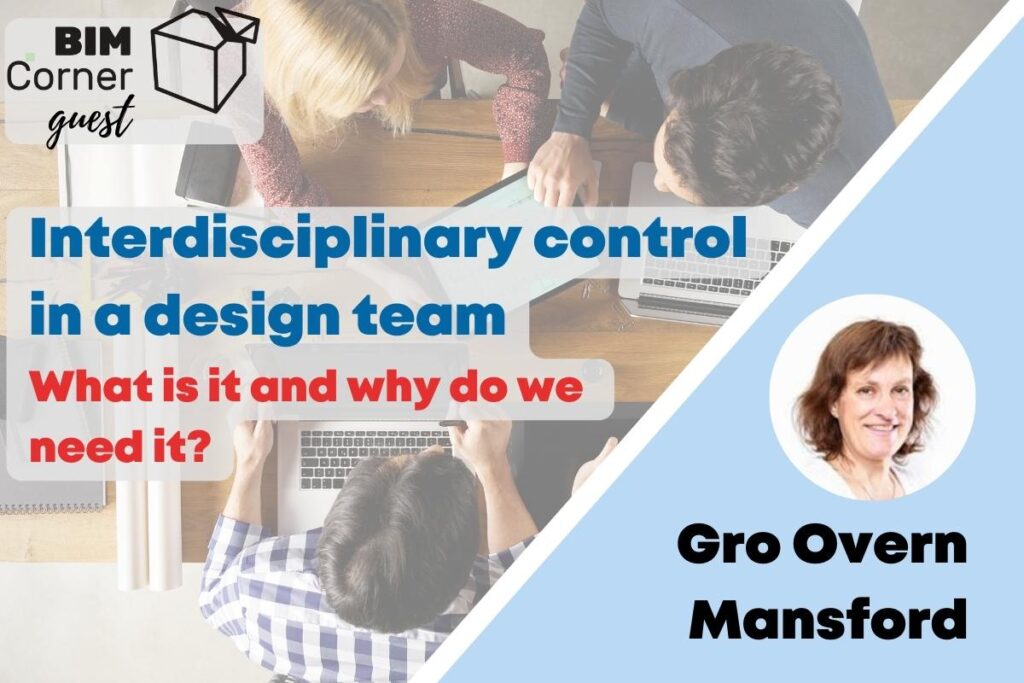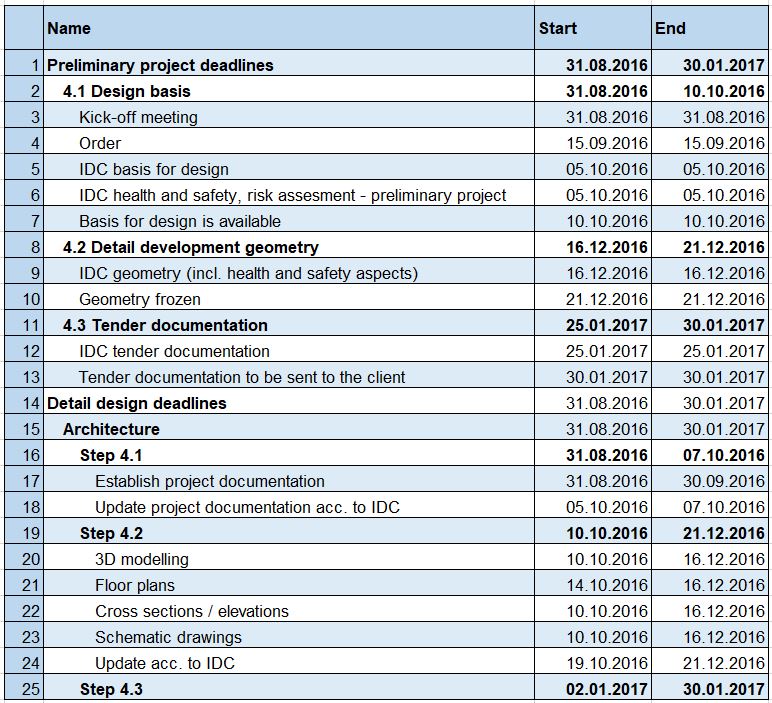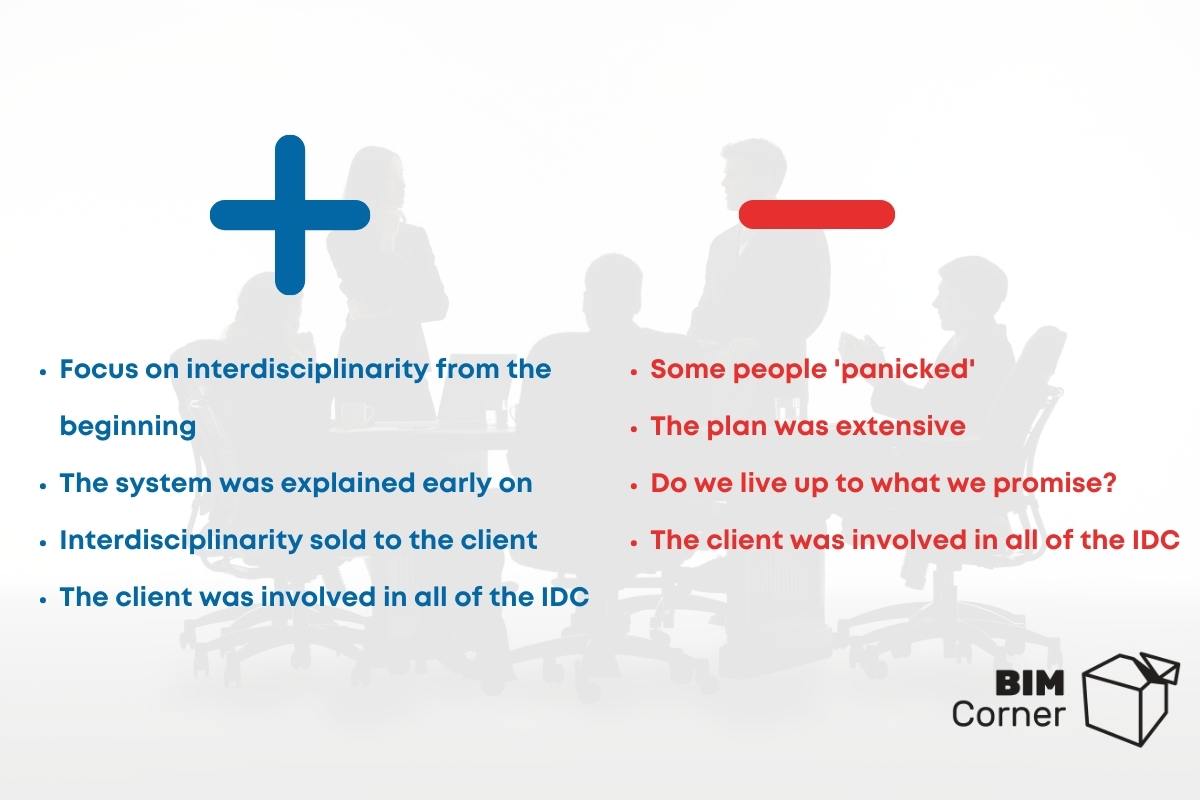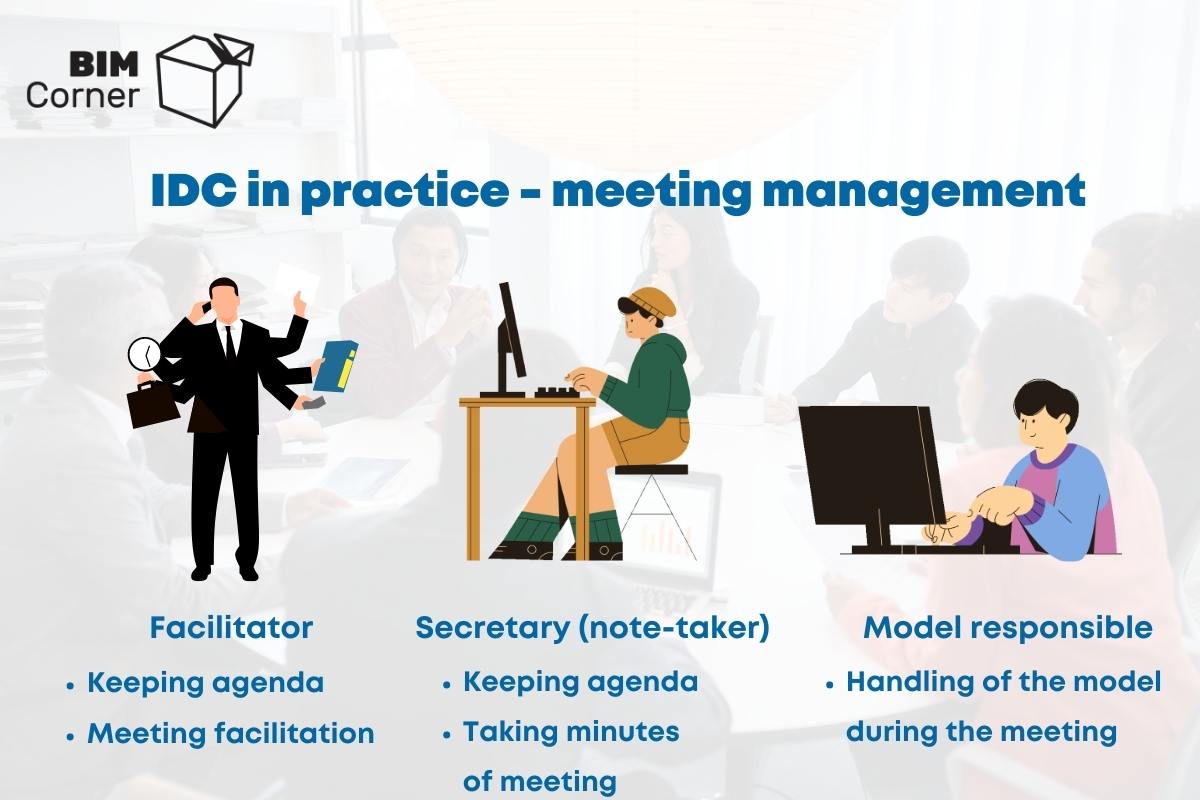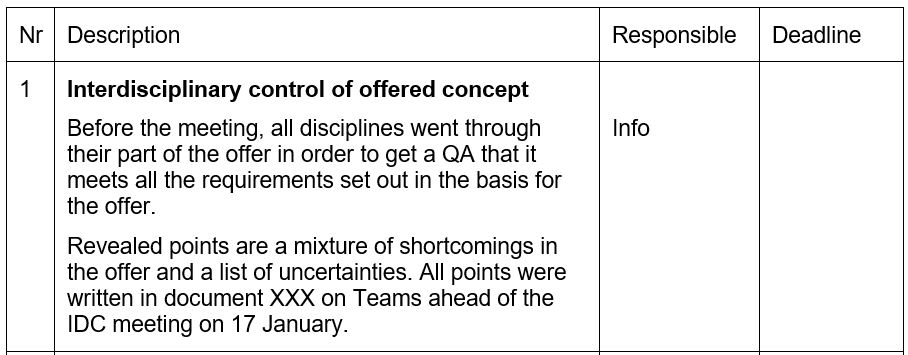The form of the interdisciplinary control, or IDC in short, may look different from project to project. As a design manager focusing on a medium sized building and infrastructure projects, my preference is a “round the table” session modelled as an ICE-meeting. In my experience this method opens up for dialogue between disciplines, and properly managed ensures that all areas of the build – as well as all disciplines involved – are sufficiently represented. That is, as long as I manage to stay on track throughout the meeting without logging myself off mid-sentence. But more on that later…
This post was written by BIM Corner’s Guest Author, Gro Overn Mansford.
This article deals with construction design management. On BIM Corner you can find series covering this topic – you can read the previous articles here:
Table of contents
1. IDC - what is it and why do we need it?
First, let’s start with a short definition. Interdisciplinary control may be defined as:
A systematic review of the product, in order to ensure that all solutions are worked through to an interdisciplinary consistent concept that may be used as a basis for choices, decisions and later detailed design of the building
The control may be done by one of several methods: as part of a meeting, as a BIM model control – either by using a clash control or another form of review – but always as an interdisciplinary control.
Why do we want to perform an interdisciplinary control?
The main goal is to combat errors in the design. The building industry is the source of a lot of errors, and the major errors in buildings have their origin in the design phase. Therefore, the aim of consultants, who are responsible for the design phase, should be to minimise the number of errors we issue out of our design offices as much as possible.
The Norwegian building industry has acknowledged this challenge for some time and initiated the Building Cost Programme as a response. The goal of the programme was to identify the sources of the design errors and to find out how we can best improve the situation in order to achieve fewer errors in our projects.
The Building Cost Programme recommended that we establish verification processes when reaching milestones, like at the end of a feasibility study, for example. In addition to this, the programme identified the version management of drawings as a key – especially with regard to the interdisciplinary dialogue between engineering disciplines. This results in the need for a focus on the interdisciplinary design process.
The design manager should initiate the IDC at the end of every phase of the project to ensure that every relevant issue is catered for. In the event that the design has not been sufficiently worked through in the design office, the consequences for the execution of the project will be significant. The lack of structure and documentation of the interdisciplinary control may lead to design errors and other interdisciplinary challenges being passed onto the building site.
👉 In short: always do an interdisciplinary control prior to the delivery of a project!
2. How to plan an interdisciplinary control?
I encourage you to plan your IDCs at the onset of every new project, at the same time as the plans for the execution of the said project are established. As a result of the recommendations listed above Multiconsult, where I work, as well as many other engineering design offices have developed their own Project Execution Models (in Multiconsults case it is called “MultiPEM”) which requires an IDC at the end of each stage of any design project. This article will describe how I planned, prepared, and performed one of the IDCs on the design of a new BREEAM-certified nursery for Oslo municipality.
The basis for the establishment of the plan is MultiPEM, which splits the design work into phases and stages. Towards the end of every stage, there should, in addition to internal control procedures in each discipline, be allocated time for an IDC. The format of the control may vary depending on the phase and stage of the project, but all of the IDCs should be visible in the project plans from the onset.
IDCs were performed in the following project stages:
Step 1 – Design basis
Step 1 does not take much time/is not time-consuming, but is an important starting point for the design process. The main goal of this step is to gather and quality check the design basis that will form the starting point for the design process. The IDC was in the example above done as a “round the table” session in a “normal” design meeting, indicated as activity number 5 above.
Steps 2 & 3 – Geometry and documentation
The IDC in these steps requires more time and focus, as the number of details and solutions to check may be vast. In this instance, the control was done as an all-day ICE-meeting (as indicated by activity numbers 9 and 12 above) with a tight schedule where all the involved disciplines were in attendance for at least a part of the day. The meetings revolved around a project-specific checklist, and there was a specific procedure in place for checking out issues after the ICE-meeting.
An important prerequisite to achieve quality in the IDC is that the drawings from all disciplines are 95% complete prior to the ICE-meeting. To illustrate the point: in the schedule below the architect drawings (activity number 23) are planned to be complete by the date of the IDC (activity number 9). The schedule for the project must be established to clearly show that all activities involving the production of drawings, and any embellishment of the BIM-model, must be completed prior to said IDC.
This plan indicates that a period of time after the ICE-meeting was reserved for any corrections or alterations that may have been necessary as a result of the interdisciplinary control (as illustrated in activity number 24 on the schedule above).
3. Advantages and disadvantages of the interdisciplinary control
Focusing on interdisciplinary issues from the onset is good, but it is also important to reassure the minor disciplines with regard to what this approach actually will mean for them. In this nursery project, I am using as an example, receiving an incomplete request for an all-day ICE-meeting caused a level of “panic”. Actually, each of the minor disciplines only participated in the ICE-meeting for approximately half an hour each, and as soon as the meeting request was edited to reflect this, the “panic” subsided.
Making the IDCs visible in the project schedules as shown, make sure of everyone’s involvement. The signal sent to the Client with regard to our focus on interdisciplinary issues throughout the design process was positively received. It also means that the expectations are increased with regard to the quality of the delivered product.
In this project, the Client was invited to participate in the IDC. This allowed the Client to observe us, but they were also made aware of all the issues that were not sufficiently coordinated at said time. This caused the designers some pain at the time, but my experience is that the Client appreciates the effort and the opportunity to contribute to the interdisciplinary process.
4. Schedule and meeting invitation – what to prepare?
Early preparation is the key! This ensures that the required members of the design team reserve the time. It is of utmost importance to have everyone available at the same time in order to fully check out all the interdisciplinary issues at hand. It is definitely an advantage to send out a meeting request early on in the project, without/despite not having a specific running plan for the day, in order to ensure that time is allocated to this event.
Here is an example of a meeting invitation:
I am inviting to a structured interdisciplinary review of the project prior to delivery. In this review, the core disciplines will sit around the table and together go through each other’s models systematically to uncover any deviations that can be corrected ahead of delivery.
During the day, we will go through a checklist/to-do list of points that are important to have control over in the project. In addition, the day will be a final quality control of the drawing documentation that is to be delivered.
In order for this review to be a success and to achieve the high quality we want, it is important that each of the disciplines has at least one representative in the meeting, and that all disciplines submit their .ifc models for compilation in advance.
And here are some tips regarding the preparations:
- Prepare a system for the meeting with a clearly visible structure. You may want to go through each part of the building and each floor in turn, or discipline by discipline. Or maybe the project is so large that it is better to divide it into control areas or sections? Establish the system early on and inform each discipline of the system so they can prepare as well as possible.
- Make sure you have the required facilities available; for example, the required software (Solibi or Navisworks), big screens, meeting facilities, food, etc. Make sure these matters are in place beforehand, so that your meeting time is not spent on running to find marker pens, get the software to function, or other similar details. All of the meeting time is valuable, and the key to a cost-efficient execution is in your preparations.
- The schedule for the meeting should be based on the system established for the control. You do not need to have everyone in the room at all times. By designing your schedule carefully, you will be able to significantly reduce the number of people present – and the duration of each person’s participation. Careful planning results in a cost and time-efficient ICE-meeting on the day in question.
- Create a check-list of all the issues that have not been cleared, collating issues from minutes of meetings and/or any to-do lists used in the design process. Sort the collated issues so that they match the schedule in advance of the meeting. Make sure to leave some free space in the check-list for any new issues that may appear during your ICE-meeting.
- To single-handedly execute an ICE-meeting on this scale is certainly not the most efficient way to do this. As design manager, you may ask for help from the team to navigate the BIM-model during the meeting, take notes for the minutes of the meeting and check-list, ensure that the time schedule is adhered to, and attend to administrative issues that may occur while you are facilitating the ICE-meeting. Believing that you alone can manage all of these tasks for the all-day meeting will likely make the meeting less efficient for the participants, who may/will have to wait for you while you complete your tasks.
Example of a detailed agenda:
Meeting agenda
Everybody participates from the start.
0900-0915: Welcome and review of the agenda for the meeting
0915-0920: Fire safety-points (Fire safety leaves after that)
0920-0930: Building physics-points (Building physics leaves after that)
0930-0940: Building acoustics-points (Building acoustics leaves after that)
0940-0950: Foundations and geotechnics for the building (Foundations and geotechnics leave after that)Short break (5-10 minutes to fill up the coffee cup and stretch your legs and back)
1000-1020: Water, sewage and storm water and landscape architecture points (Water, sewage and storm water and landscape architecture leave after that)
1020-1030: Structural-points
1030-1100: Architectural-points (Structure and architecture leave after that)Short break (5-10 minutes to fill up the coffee cup and stretch your legs and back)
1110-1130: Electrical-points
1130-1200: HVAC-points
1200-1230: Summary of the meeting and AoB (any other business)
👉 Tip: All disciplines are expected to have performed their controls in advance of the interdisciplinary control. They should also have performed a review of the other disciplines’ work in advance of the ICE-meeting.
5. The big day is here – what do I do?
Your detailed preparations should start a couple of days in advance of the ICE-meeting. Recruit an assistant and define the tasks you want this person to do in order to ensure an efficient meeting. If you recruit a fellow project member to write the minutes of meeting, make sure the person you recruit is not one of the main contributors to the interdisciplinary issues. It is better to recruit someone who is less involved in the project. Often, I have recruited a younger engineer with less interdisciplinary experience to take the minutes of meeting on my behalf – which in turn gives the young person in question an opportunity to learn.
Another key point is clear communication with each of the disciplines in advance to ensure that they bring the expected/required elements to the ICE-meeting, that they deliver the necessary documentation for review by others in advance, and that this is to the correct level of quality.
One last quality control of the schedule in advance of the ICE-meeting is recommended, as there may be some last minute issues that require everyone’s attention while you are all gathered in one place.
👉 Tip: Both technical support systems and coffee are important for a successful meeting – it will pay to have both sorted in advance.
It is a good idea to prepare set views in the BIM-model during the last days before the meeting, as well as opening the model before the meeting starts to ensure everything is in place – especially if the meeting is held in a new facility.
Practical tips on facilitating the ICE-meeting
- Once the meeting starts, go through the schedule for the meeting and emphasise the importance of precise and short comments so that the meeting stays on schedule throughout the day, and the group is able to discuss all the subjects and issues planned for the day. You should also specify that there is no room in the schedule to perform design work or complete previously assigned tasks. Such activities will have to be attended to after the ICE-meeting.
- The facilitator role is a demanding role, and you must be alert at all times. You cannot afford to take notes yourself, as you will lose the attention of the attendees, and with that, the control of your meeting. You, as the facilitator, should focus on driving the discussions forward and steer these into conclusions within the assigned time frame, while ensuring that the groups at all time focus on the most critical issues at hand. Request your assistant to take copious notes, as this will enable you to remember the context for each issue when later creating the basis for the preparation of the minutes of meeting. Your assistant should also keep one eye on the schedule at all times, and may also summarise each issue briefly before you move on to the next. I recommend that your BIM-coordinator, or another meeting participant that is able to navigate the BIM-model (for example the architect), is in charge of displaying the 3D-model on the big screen during the meeting. In this way you, as the meeting facilitator, are able to focus on the issues up for discussion at all times.
6. After the interdisciplinary control ICE-meeting
Following your IDC-meeting, your first task at hand is to create the minutes of the meeting. The shape & form of this is dependent on several factors:
- Should you be able to tick off completed tasks?
- Will it be used as a tool to identify any uncompleted tasks?
- Should the list be interactive, so that the disciplines themselves can tick off completed tasks, or should the design manager have sole rights to close completed tasks?
- Could the checklist be created and shared via the collaboration platform?
My practice is to establish “traditional” minutes of meeting on my company’s template where the date, time, and participant names are recorded. The rest of the minutes of the meeting template is not used, as I prefer to enclose a copy of the specific checklist (including notes made on the day) as a part of the document. Alternatively, the checklist is listed as a reference in the minutes of the meeting.
The checklist
My “gross” checklists contain all issues discussed in the ICE-meeting. After the meeting, I use this “gross” list as a basis for the more systematic, “net” checklist enclosed in the minutes of meeting. The “net” check-list should at least have the following properties:
- Unique numbering of tasks
- Describe controllable factors
- Appoint a person responsible for solving the issue
- Description of action required
- Space to allow brief comments from the responsible person
- Space to sign off actions as completed
In the event that you choose to use Excel for this purpose, the list may look as follows:
The editable checklist should be made available to all participants in the collaboration platform as soon as possible after the ICE-meeting, in order that each responsible person may tick off their tasks themselves as they are resolved. As soon as the deadline for completing tasks has passed, the design manager should go through the list to ensure that all unresolved issues have been taken care of.
👉 Tip: The format is not important – what is important is that you establish a system that cannot be misunderstood – and that it is one that fits the project.
Summary
As design manager it is important to perform a systematic review of the designed product, in order to ensure that all solutions are worked through to an interdisciplinary consistent concept that may be used as a basis for choices, decisions and later detailed design of the building. The manner by which the IDC is done may vary from project to project. Some are done as ICE-meetings, some as paper or model-based controls consisting of passing around technical models/drawings between disciplines who signed a check box to show that their control was complete. This article has described how an IDC may be conducted in the format of an ICE-meeting.
When planning the IDCs to be performed in your project, it is important to:
- make the process visible in the project schedule from the beginning
- ensure that all relevant disciplines and issues are addressed
- define the level and content of each IDC clearly
- describe the preparations to be done in advance by each participant
- communicate the level of involvement expected from each participant clearly
Remember that the follow up and proper documentation of the IDC is legally required, so make sure to allocate sufficient time to finalise this when the IDC is complete.
During COVID, I performed several IDCs as digital ICE-meetings on Teams. I will never forget one such meeting in particular. We were about 2 hours into the meeting, and had already changed from sharing the check list to sharing the BIM-model and back several times. At this point we were about to change from one discipline to another and there were around 15 participants in the meeting. The BIM-model was on the shared screen and my intention was to change the common screen in order to share the check list on my screen with the group. I was mid-sentence when I managed to click on the red “leave” button rather than the black “share” button!
My pulse went through the roof, of course, and it felt like an eternity before I managed to re-enter the meeting again only to be met by loud roars of laughter from all the participants – and my client! His welcoming comment was “Haha, I believe Gro managed to hang up on us!”


